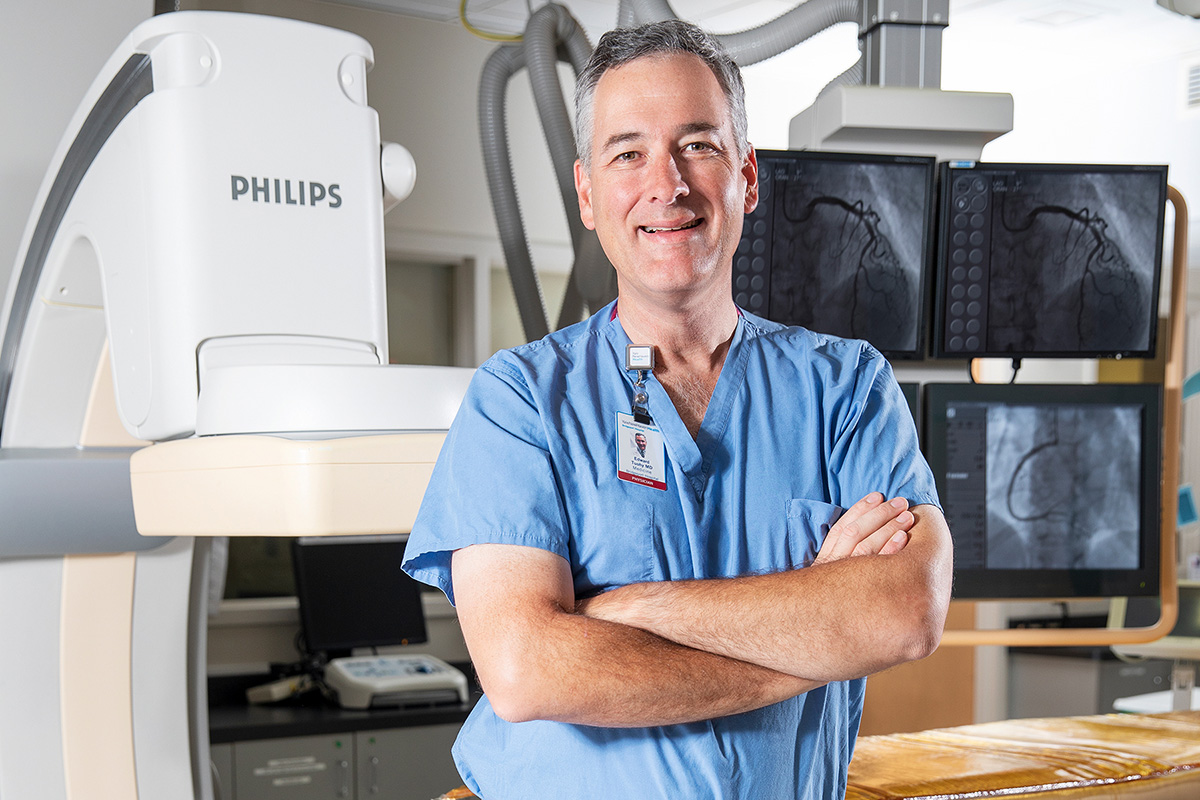
Popular Locations
- Outpatient Surgery - Bridgeport Hospital
- Park Avenue Medical Center
- Primary Care Center - Bridgeport Hospital

Published January 30, 2023

If a tightness in your legs is literally cramping your style and your ability to walk short distances without stopping to rest, you are not alone. Millions of Americans suffer from peripheral artery disease (also known as peripheral arterial disease or PAD) and recognizing the condition early is a critical first step in slowing its progression.
“People who have peripheral arterial disease typically suffer, initially, from what is called exertional leg angina,” said Edward Tuohy, MD, a Northeast Medical Group cardiologist who specializes in interventional cardiology at Bridgeport Hospital’s Heart and Vascular Center. “This pain, known as claudication, is caused by blockages in the blood vessels that do not allow enough blood flow to satisfy the energy requirements for exercise and walking.
“You’ll see someone who can walk 100 yards and then their calves cramp up and they have to stop walking,” Dr. Tuohy said. “Then, if they wait a little while, they can walk farther. That’s the first stage of it.”
People may also experience symptoms such as coldness in the lower leg or foot, or leg numbness or weakness. As fatty deposits of plaque build up in the arteries in a process known as atherosclerosis, it can lead to resting ischemia or rest pain, which is constant pain in the feet or legs due to a lack of circulation. At its worst, people with PAD can develop wounds that can be limb- or life-threatening.
While untreated PAD can lead to devastating consequences, it doesn’t usually happen overnight. “It’s not a process that happens quickly,” said vascular surgeon Hannah Zwibelman, MD, assistant professor of clinical surgery (vascular) at Yale School of Medicine. “It’s something that happens over time. Your textbook person with PAD walks in the office and either has a history of smoking or is currently a smoker.”
Other risk factors include a history of diabetes, a history of high blood pressure and high cholesterol and, often, a family history of heart disease.
“We are usually talking about older adults, but not always,” Dr. Zwibelman cautioned. “We’ve had such an epidemic of type 2 diabetes in young people, so I’m seeing 30-year-olds who have terrible blood vessel disease because of their diabetes – and they’re coming to our office with wounds at a more severe stage.”
Women also tend to be at risk for more progressed disease. “Usually, women just don’t report it, or their symptoms aren’t recognized for PAD,” Dr. Zwibelman explained. “So, in women, it tends to be very underdiagnosed. Unfortunately, it also means that they are at higher risk for limb loss because they present later with more severe disease.”
Screening for PAD can be as simple as checking pulses and measuring the blood pressure in the foot versus the blood pressure in the arm. Treatments can vary.
“A lot of peripheral disease does not require interventional treatment or surgical treatment,” Dr. Tuohy said. “The first line is the same treatment as we have for coronary artery disease, where we administer antiplatelet agents, like aspirin, and we also do very aggressive cholesterol lowering.” Monitored exercise programs can also be helpful.
“Cardiology and vascular surgery physicians are good at doing what’s called minimally invasive or endovascular therapy, and that is to treat blood vessels from the inside,” Dr. Tuohy said. “Just like we put stents in coronary arteries, we can go into blood vessels in the legs and balloon things open and put in stents to modify blockages and restore blood flow.”
“We treat PAD based on the symptoms the patient is having,” Dr. Zwibelman explained. “Anyone who has progressed to severe PAD, to the point where they have rest pain or a wound that is not healing, is automatically considered for surgery.”
In severe cases, open bypass surgeries are sometimes warranted. Bypass surgeries redirect blood flow around blocked blood vessels by creating a new pathway for blood flow using a graft or pieces of a vein or artery. Depending on the procedure, a bypass surgery on a lower extremity can take four to six hours, requires a hospital stay of several days and often several weeks of rehabilitation.
“We usually do endovascular surgery first; it is definitely the most common procedure we do,” Dr. Zwibelman said. “But depending on where the disease is located in the body and how severe it is, sometimes surgical bypass surgery – even though it’s bigger – is the right surgery to do.”
Learn more about Heart and Vascular Services at Bridgeport Hospital
Atherosclerosis – a disease of the arteries that develops when plaque builds up inside the walls of the artery.
Claudication – pain caused by too little blood flow to muscles during exercise, like walking.
Endovascular surgery – procedures performed using minimally invasive catheter techniques on the arteries or veins.
Peripheral artery disease (also called peripheral arterial disease) – a common condition in which narrowed arteries reduce blood flow to the legs and arms.
Rest pain (or critical limb ischemia) – a constant burning pain felt in the lower leg, feet or toes.
Sign up to receive valuable information about heart health.